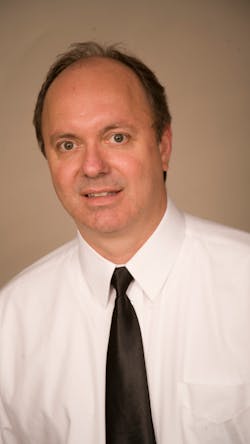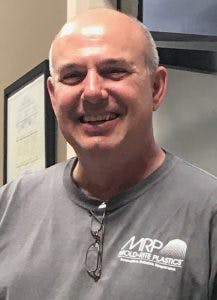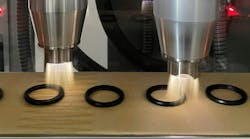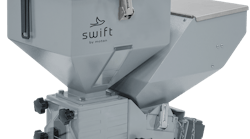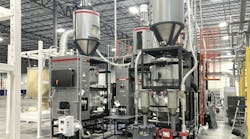Problem: An injection molder that added a facility near an existing plant needed more oversight over its auxiliary equipment.
Solution: Conair’s FLX-128 Plus Control Systems, SmartServices web-monitoring program and blenders combined to provide full insight into materials-handling operations.
The complexity of going from one manufacturing site to two might have made automation supervisor Todd Duprey’s life twice as hard.
But Conair’s FLX-128 Plus Flexible Control System, together with the company’s SmartServices web-based dashboard for auxiliary equipment monitoring, management and analysis, gave him control.
“We actually have two of them,” said Duprey, a longtime employee of Mold-Rite Plastics (MRP) Inc., an injection molder that began implementing the FLX-128 Plus systems in July. “The first one works so well, I bought a second one.”
The ability to leverage data and to identify and respond to problems at any time, from anywhere, can set companies such as MRP apart from their less-advanced competitors, said Alan Landers, blending product manager for Conair.
“With the pandemic hitting, we’ve seen even more of a growth curve, for people that have data that can be accessible from their homes, for instance, or from remote worksites from the plant,” Landers said. The technologies allow “people to be able to see not just one factory, but all their factories on one single SmartServices portal.”
Keeping watch over many runs
A maker of jars and child-resistant caps, MRP does a lot of work for smaller businesses. It makes both custom products and stock items.
“So, they might only want 100 boxes of this or 100 boxes of that. Or it could be up to 30,000 boxes of something,” Duprey said.
That means a lot of color and recipe changes, leading to downtime and material waste. For Duprey, the potential inefficiency — always an issue with small volumes — increased over the summer. That’s when the site where he works, at 1 Plant St. in Plattsburgh, N.Y., began preparing a second facility across the street, at 4 Plant St.
The company has an FLX-128 Plus system at the new facility, as well as a second system, to control 17 Conair receivers, at 1 Plant St. The Conair systems are designed to manage as many as 128 receivers, 256 source valves and 40 pumps, in addition to two backup pumps.
The connectivity offered by Conair makes it possible to juggle the demands of two plants.
“If it were not for this system, it would mean running back and forth,” Duprey said.
The newest Plattsburgh facility — a converted warehouse still in transition to production — has a handful of small presses, while the main facilityCoordinating all that activity falls to Duprey, but it was the personal touch, rather than advanced technology, that first led him to Conair. He said he was impressed by the availability of service technicians who are on call 24/7.
“So, now I’m working with somebody that’s out in Pennsylvania, their headquarters, and, actually, I had somebody on the phone from Texas last week working on issues, so that’s the selling point for this to me,” he said. “I mean, if I really wanted to sit at my house, I can look at everything that’s going on at 4 Plant St. and [that] tells you where levels are, tells you what’s running, tells you what kind of alarms they’ve had, tells you what kind of issues they’ve had without even being on site.”
That’s why, over time, as it has replaced auxiliary equipment, MRP Plattsburgh has turned to Conair.
Recent upgrades include the acquisition of 20 blenders connected to SmartServices, which allows operators to set thresholds, such as color ratios, and sends emails when there’s an issue. It also tracks materials as they’re processed, giving MRP another way to check the estimates it quotes customers against its actual costs.
“With the SmartServices capability, it allows us to, for instance, measure the utilization of a particular vacuum loader that’s on the system. Or actually we can measure the performance of every vacuum loader on the system,” Landers said.
Unlike the blenders they replaced, which signaled problems only through traditional light towers, MRP’s new blenders can be programmed to send warnings to the devices or computers of specified personnel.
“With one of my old-style blenders, if it ran out of color, for instance, it would alarm and it would shut down. A light would go off and sometimes an operator would know about it. Sometimes they wouldn’t. Sometimes we couldn’t get a process tech over there or we couldn’t get the right person to address the problem,” Duprey said.
“So now we’re not waiting for it to go down anymore, or we’re not waiting for a reaction. We can act before something happens,” Duprey said.
Complicating things, some older auxiliary equipment uses hard-to-decipher codes to indicate the problem and doesn’t necessarily even identify which line or piece of equipment is experiencing the issue. The new interfaces are more user-friendly and intuitive. They require less training, and give operators the information they need to identify which line or piece of equipment is running out of spec.
It all adds up to less guesswork and more uptime.
“We have a reservoir underneath each blender that holds about an hour’s worth of material, so we’ve got an hour to react,” Duprey said. “That’s awesome because it gives us an hour to get somebody over there to fix the problem before it actually causes us downtime.”
While Duprey wants MRP to transition all its auxiliary equipment to Conair technologies, that will have to wait, as such an investment will take time. In the meantime, Duprey said in mid-January that two more blenders were on the way.
For now, he’s satisfied by the efficiencies he’s already gained.
The technologies make it possible to avoid waste, but he said he doesn’t yet know how much less scrap MRP is molding due to the control it has gained since adopting the FLX-128 systems. Time savings is benefit enough.
“It’s the time that's the bigger issue,” he said “It’s the troubleshooting. It’s finding the problem now instead of two hours from now,” he said.
Contact:
Conair Group, Cranberry Township, Pa., 724-584-5500, www.conairgroup.com

